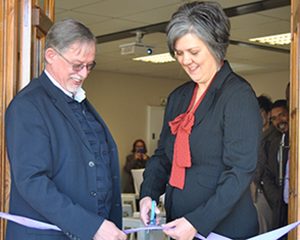
Ribbon cutting, Prof van Zyl and Ms du Plessis
Venter (community member)
The Faculty of Health Sciences of the University of the Free State (UFS) has, as part of its commitment to student and community development, established a student residence in the town of Trompsburg in the Kopanong Local municipality, Xhariep District municipality in the Southern Free State. The Faculty officially opened the Faculty of Health Sciences Rural Community Initiative on 14 and 15 June 2017. The memorial plaque was unveiled by Prof Gert van Zyl (Dean of the Faculty of Health Sciences) and Prof Francis Petersen (Rector and Vice-Chancellor of the University of the Free State)
The importance of the residence
The goal of the ‘Kopanang le fodise – Unite to heal’ programme is to develop a community-centered collaborative framework for sustainable, holistic healthcare and social development incorporated in the curricula of the Faculty.
Background of the project
During 2016 a total of 324 fourth-year students of the Faculty have each spend at least a week in interprofessional groups in primary healthcare facilities in the Kopanong municipality on a Community Based Education, Interprofessional Education (CBE-IPE) platform in Trompsburg and Springfontein.
To facilitate student rural placement the former Midway guesthouse currently includes seven (7) facilitator units with on suite bathrooms, two (2) fully equipped lecture facilities, a recreation room and a library with computers and internet access. The newly developed student residence has 10 apartments that can each accommodate six (6) individuals. A housemaster resides on the premises and acts as manager of the facility. All areas of the residence are Wifi covered and 24h security service is in place.
The ceremony was attend by the following partners
University of the Free State (UFS)
Rector and Vice Chancellor of the University of the Free State, Prof Francis Petersen.
Members of the UFS council, Dr Vinger and Dr Swart
Dean of the Faculty of Health Sciences, Prof van Zyl.
The Head of the School of Allied Health Professions, Dr van Vuuren.
The Head of the School of Medicine, Prof Kruger.
Faculty from the Faculty of Health Sciences.
Members from UFS institutional support department: ICT, Finance, Facilities management
Kopanong local municipality
Councilor Basholo, representing the Kopanong local municipality.
Kopanong local community members
Free State Department of Education (DoE)
Free State Department of Health (DoH)
Private sector partners
Mr Burgess, CEO of MDG Heath Solutions
The Mother And Child Academic Hospital (MACAH) represented by Prof Venter, head of department of Paediatrics, donated two (2) state of the art baby scales to the rural health programme.